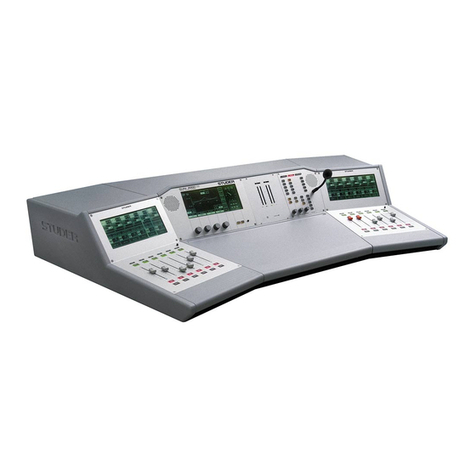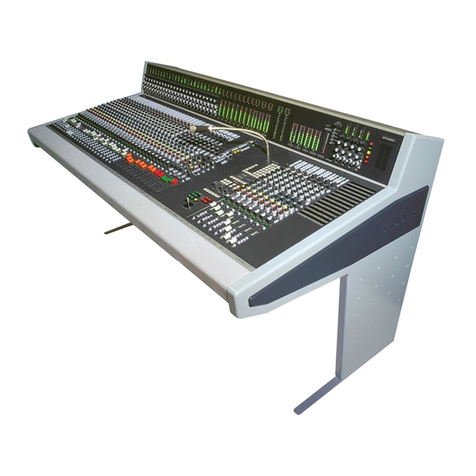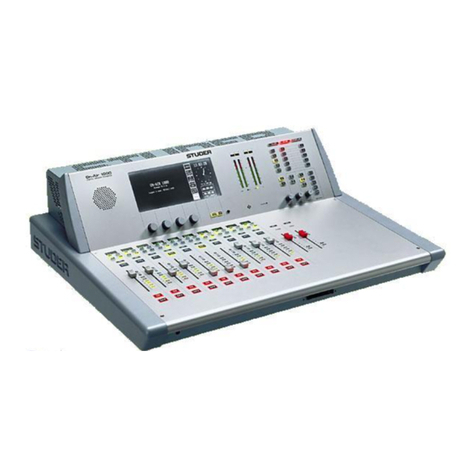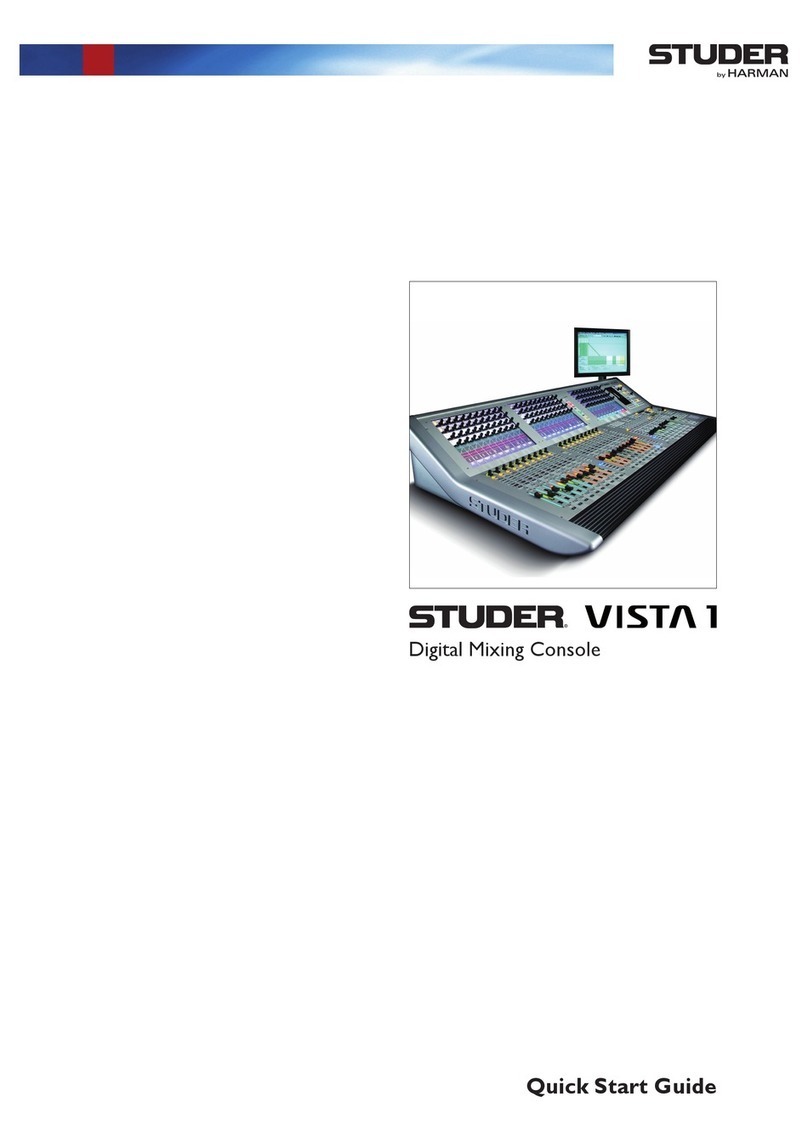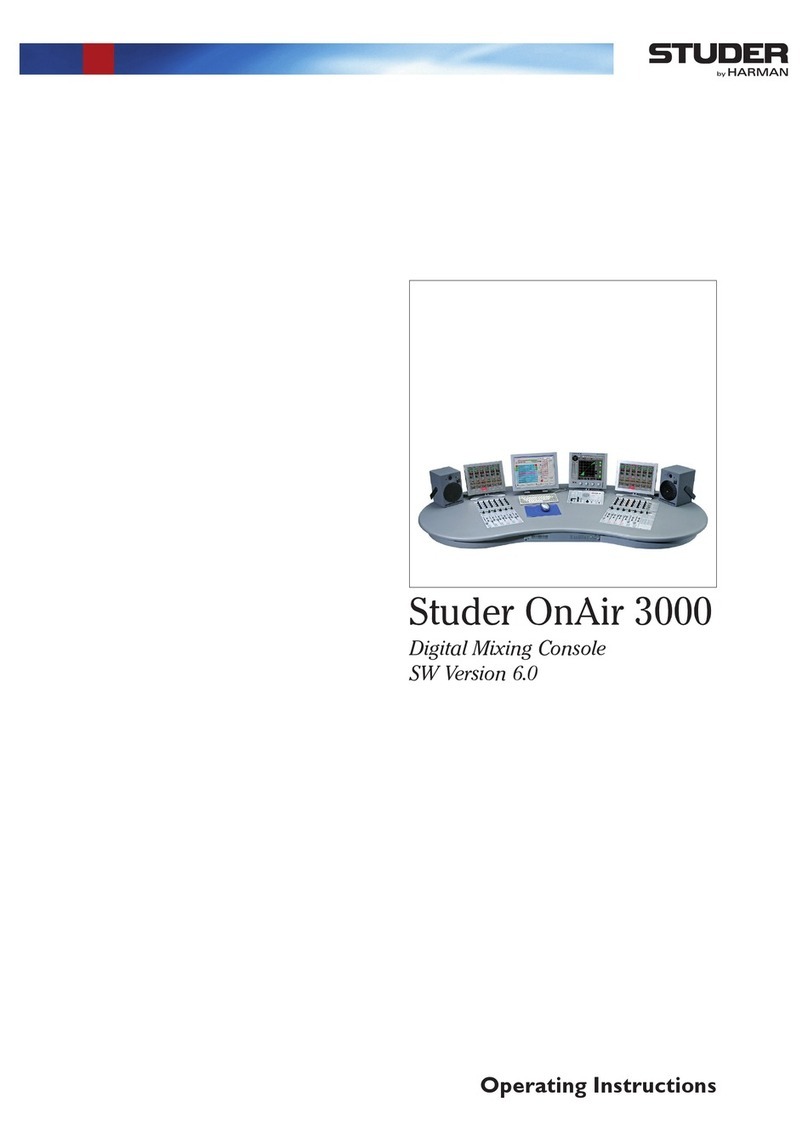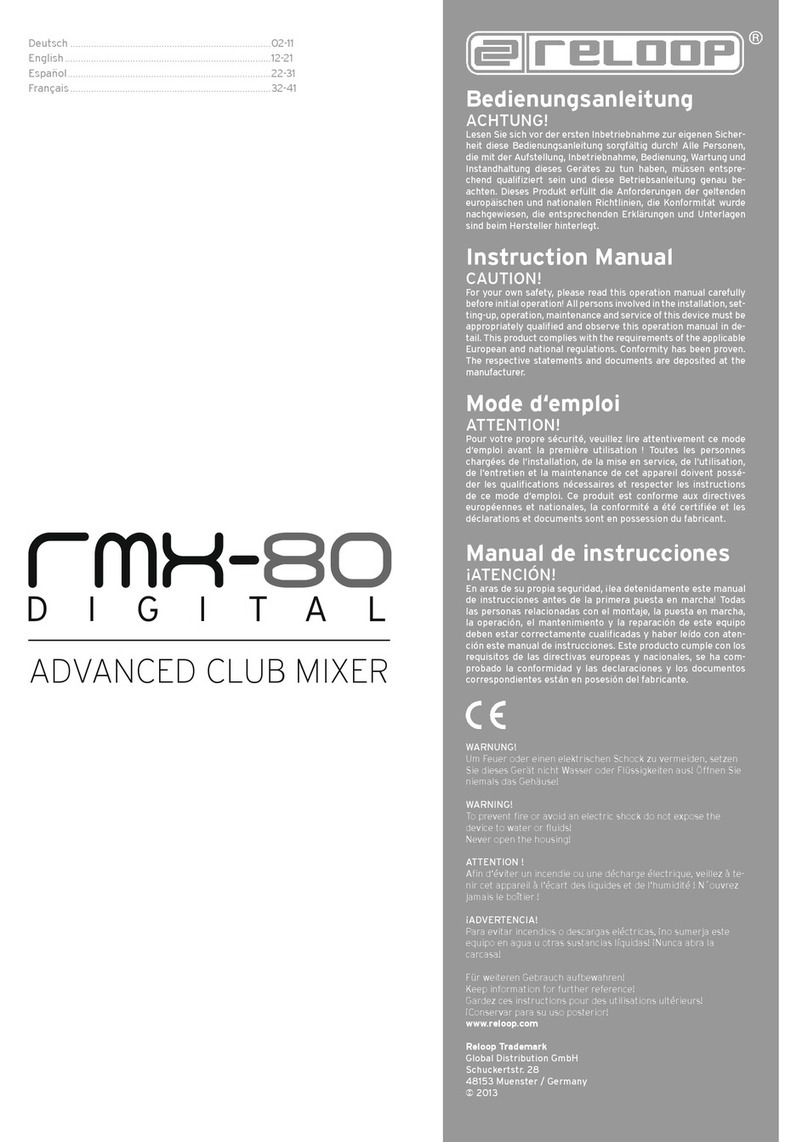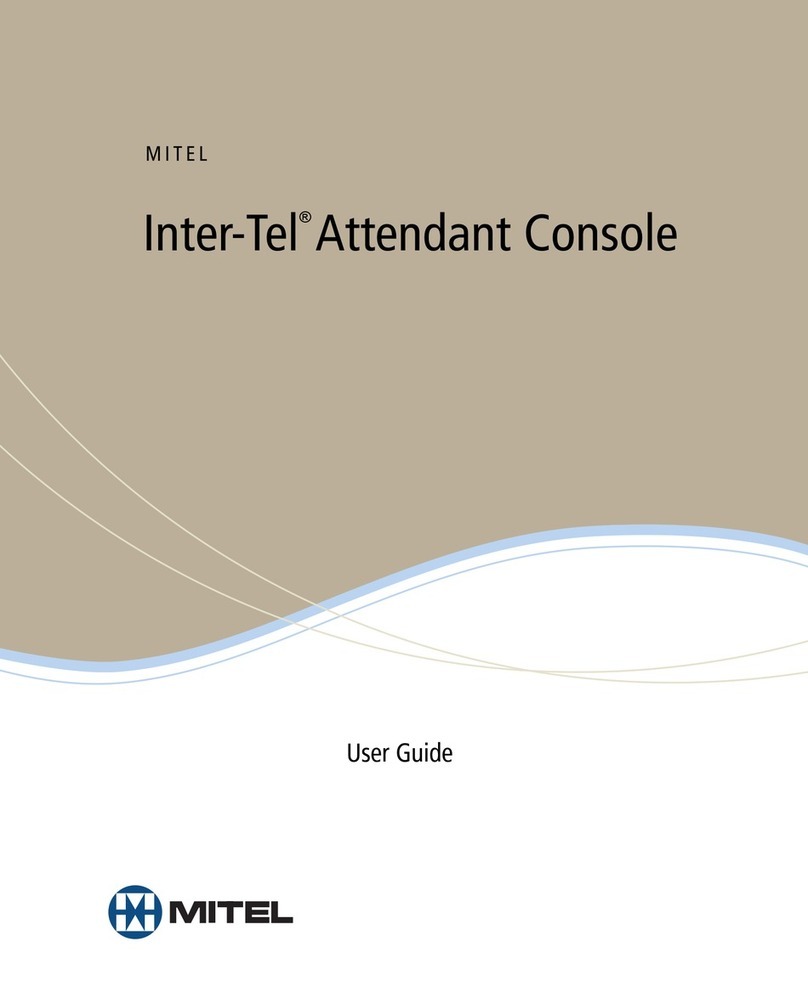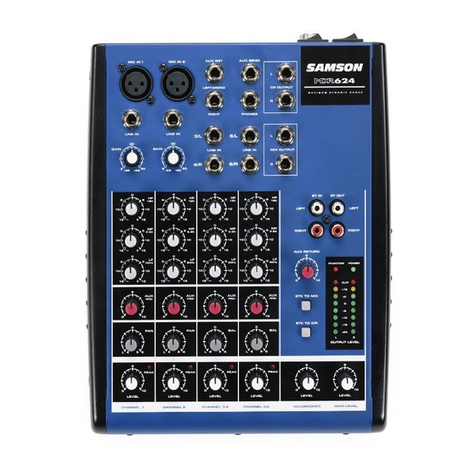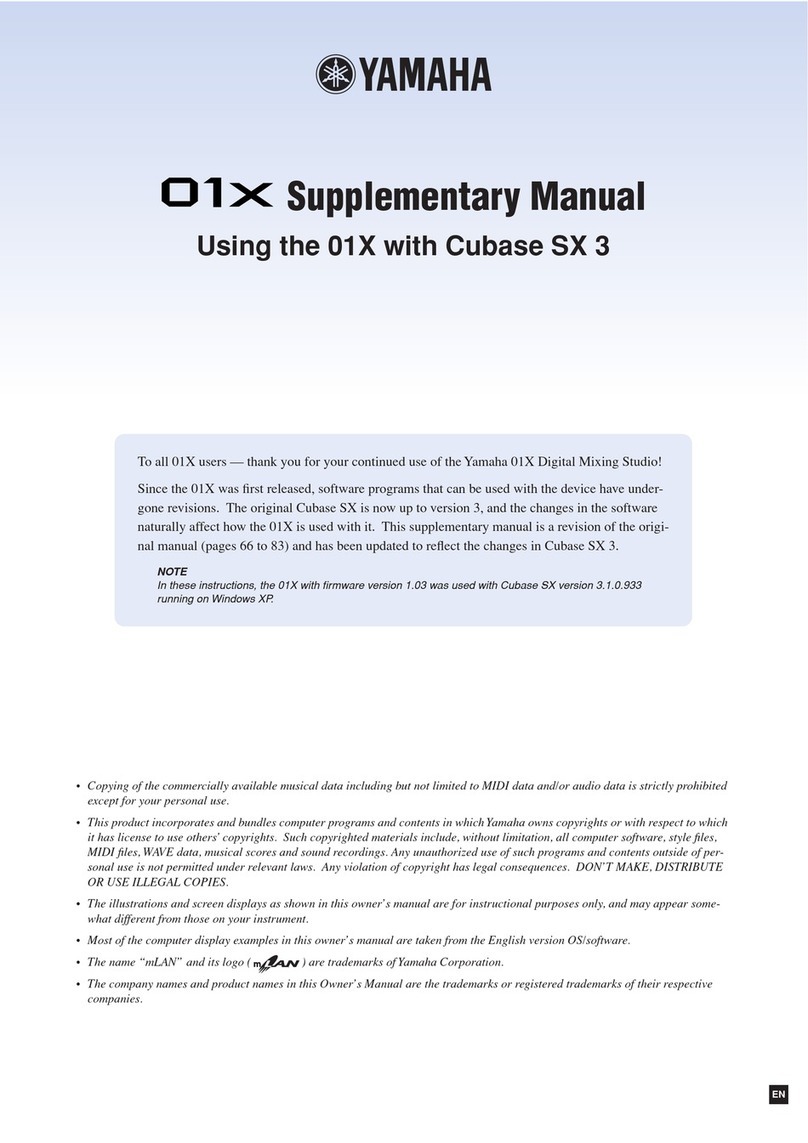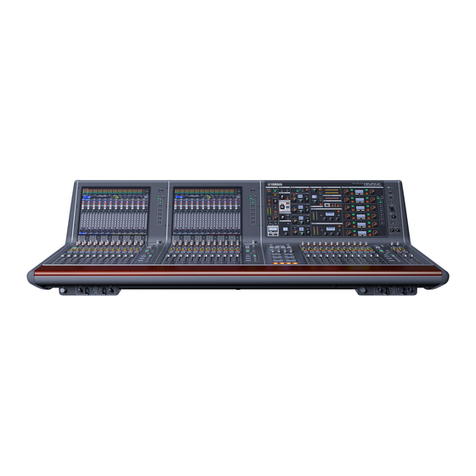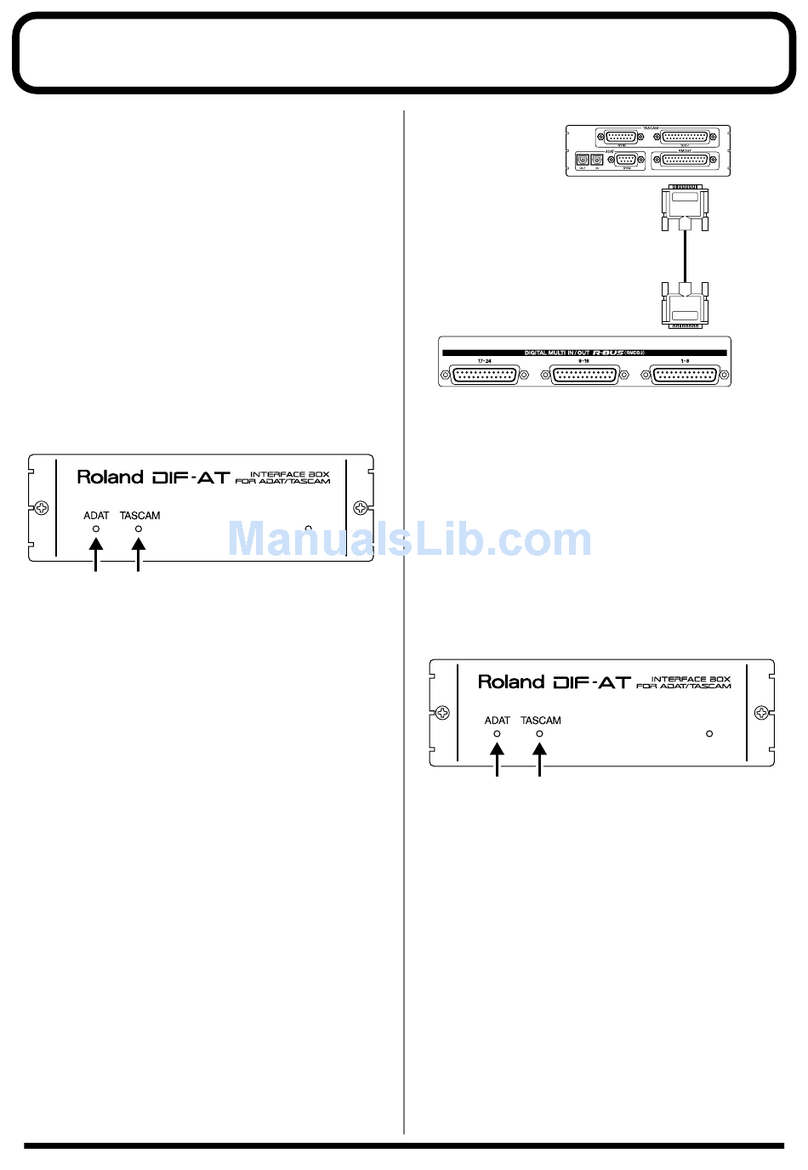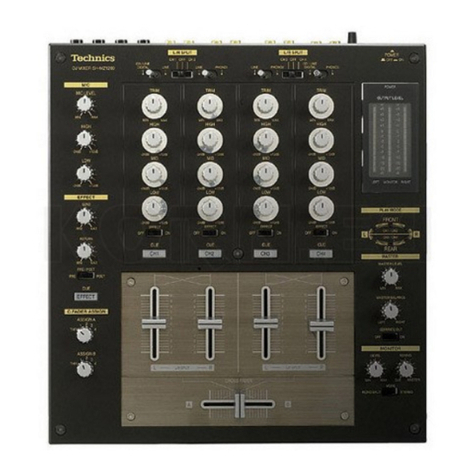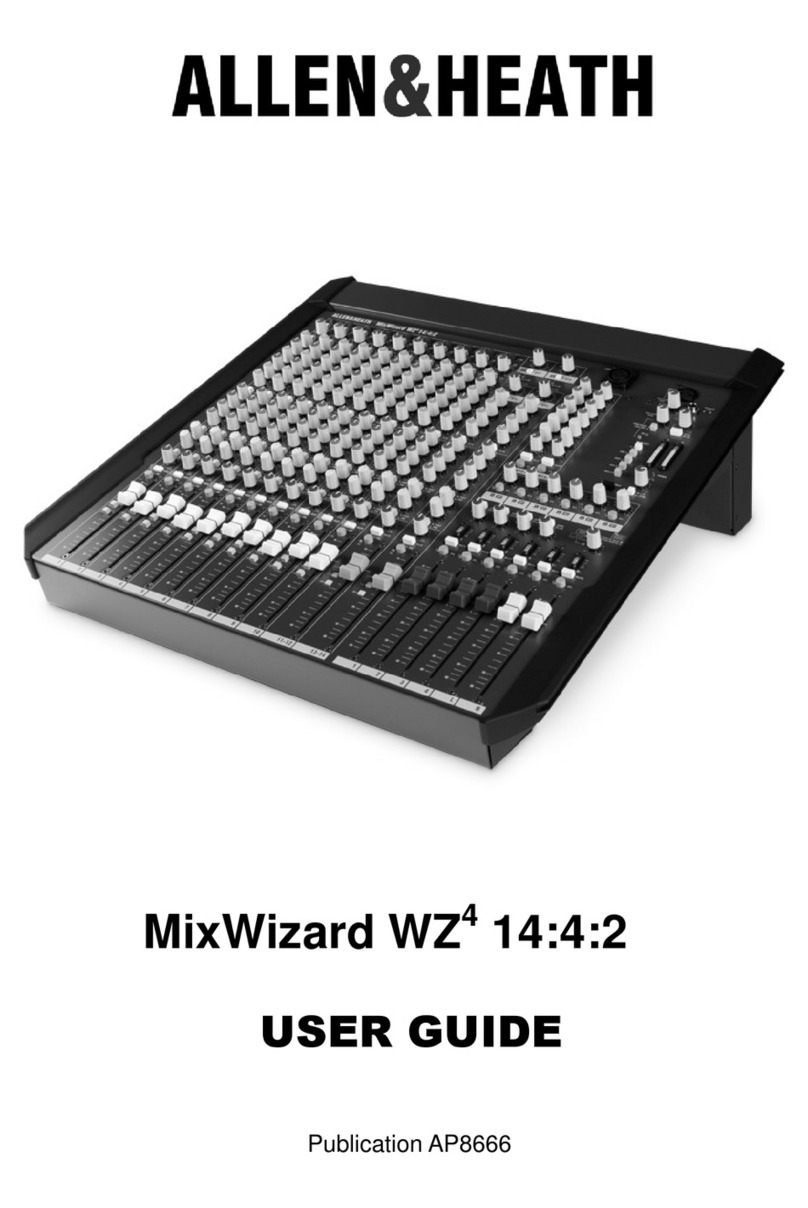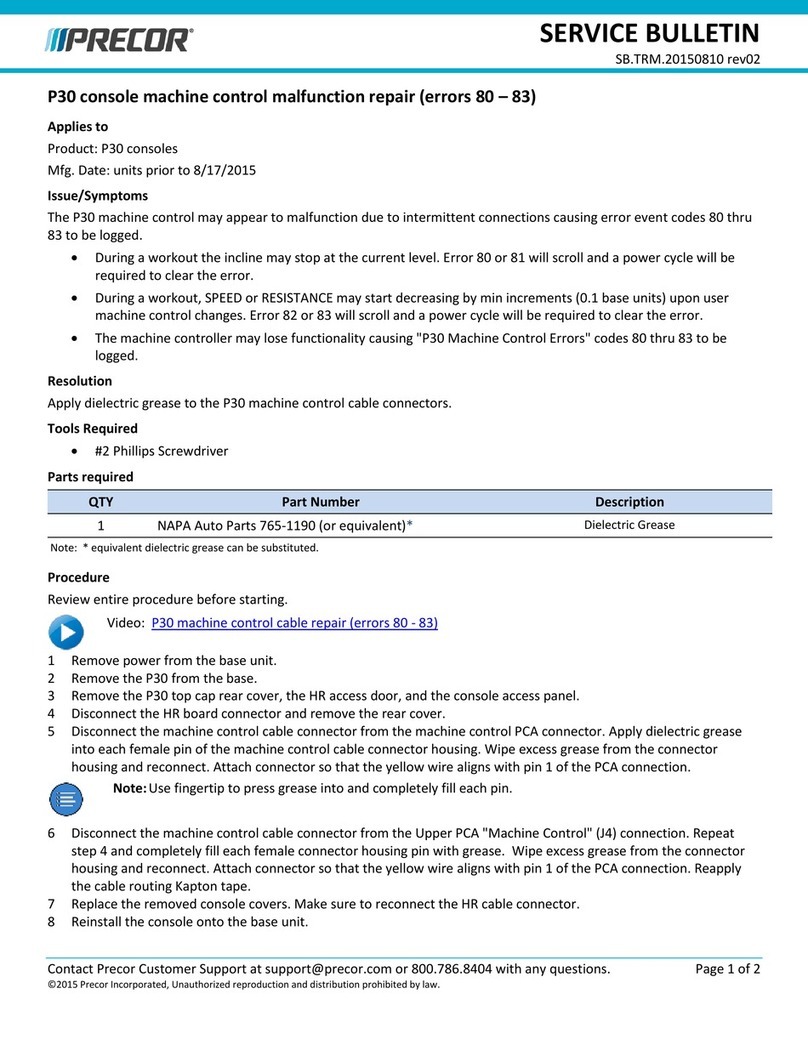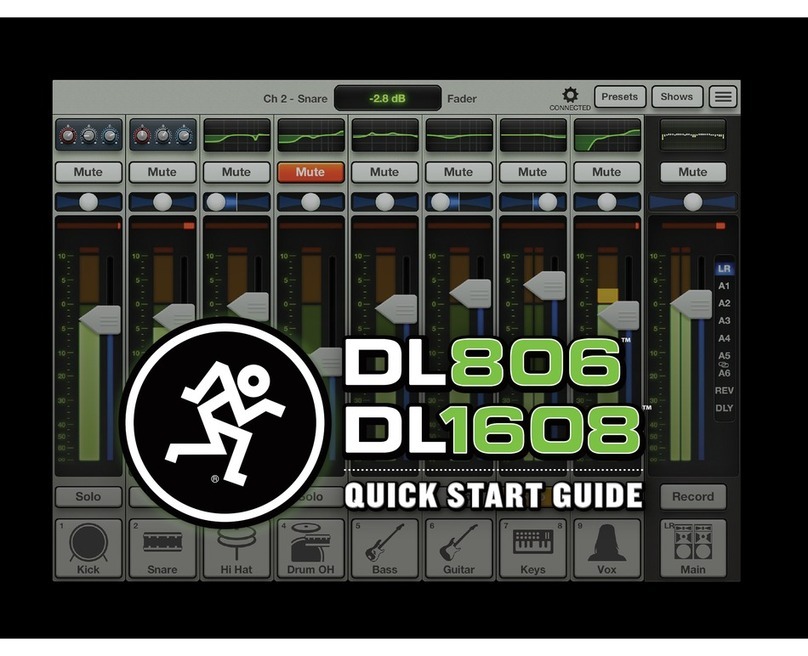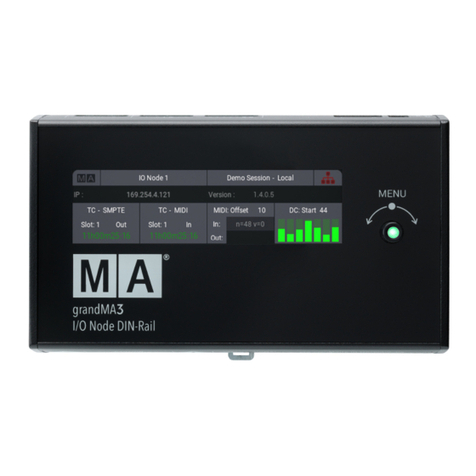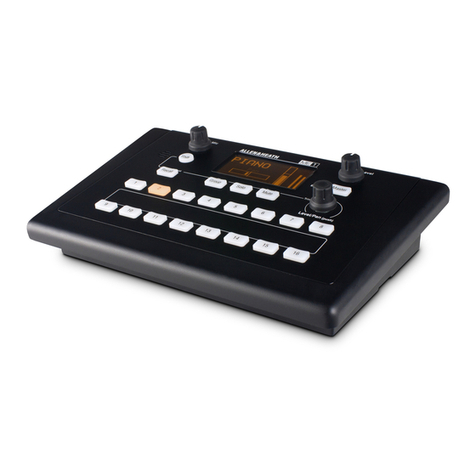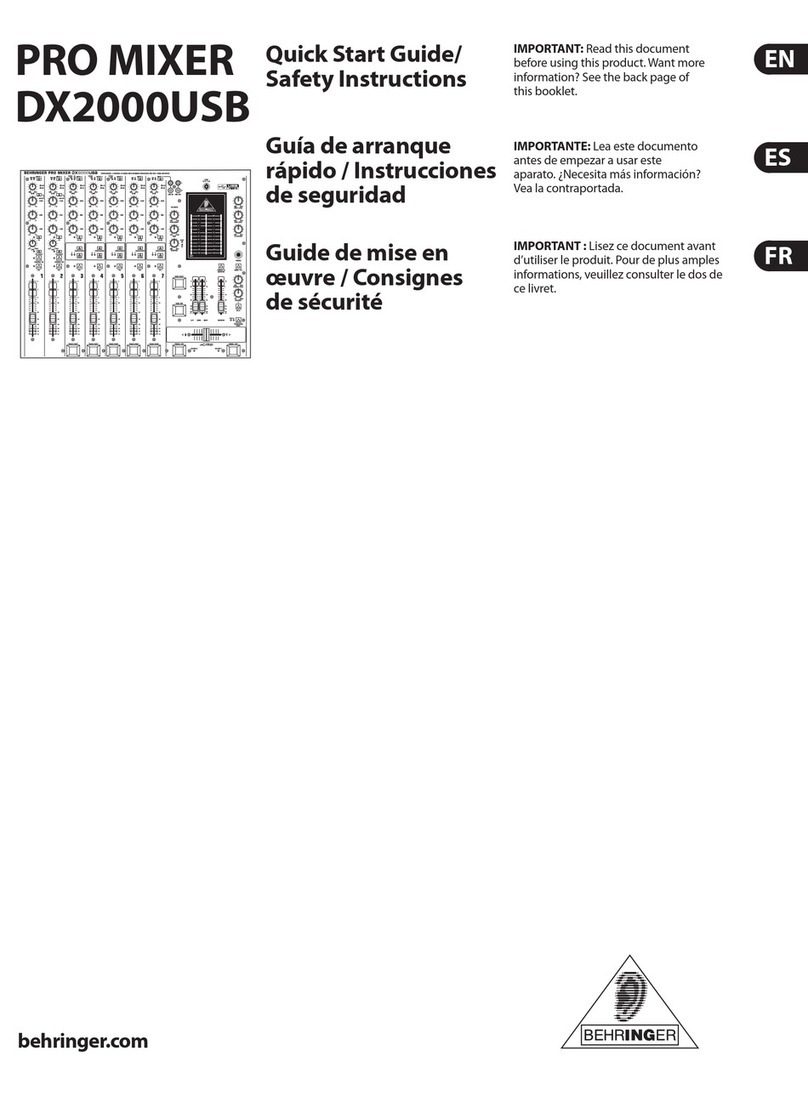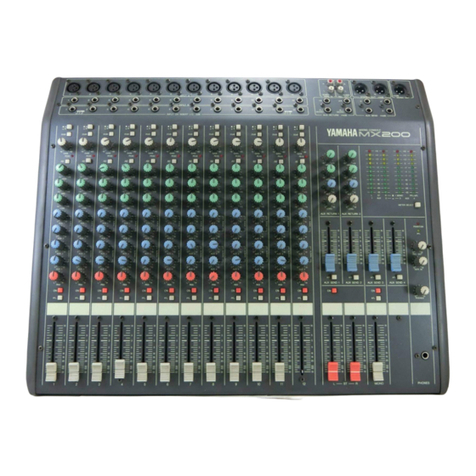Studer OnAir 3000 Operating instructions

OnAir 3000
Digital Mixing System
1. Audio Block Diagram, System Wiring
2. Desk Modules
3. DSP Modules
For information on the D21m I/O system please refer to the separate documents BD10.275102
and BD10.275113
Service Instructions

Prepared and edited by Copyright by Studer Professional Audio GmbH
Studer Professional Audio GmbH
Technical Documentation Order no. BD10.275124-3 (0311)
Althardstrasse 30
CH-8105 Regensdorf – Switzerland
http://www.studer.ch Subject to change
Studer is a registered trade mark of Studer Professional Audio GmbH, Regensdorf

I
For Your Own Safety and to Avoid Invalidation of the Warranty
Please Read This Section Carefully
• Readtheseinstructions.
• Keeptheseinstructions.
• Heedallwarnings.
• Followallinstructions.
• Donotusethisapparatusnearwater.
• Cleanonlywithadrycloth.
• Donotblockanyventilationopenings.Installinaccordancewith the
manufacturer'sinstructions.
• Donotinstallnearanyheatsourcessuchasradiators,heatregisters,
stoves,orotherapparatus(includingampliers)thatproduceheat.
• Donotdefeatthesafetypurposeofapolarisedorgroundingtypeplug.A
polarisedplughastwobladeswithonewiderthantheother.Agrounding
typeplughastwobladesandathirdgroundingprong.Thewidebladeor
thethirdprongareprovidedforyoursafety.Iftheprovidedplugdoesnot
tintoyouroutlet,consultanelectricianforreplacementoftheobsolete
outlet
• Protectthepowercordfrombeingwalkedonorpinchedparticularly
atplugs,conveniencereceptaclesandthepointwheretheyexitfromthe
apparatus.
• Onlyuseattachments/accessoriesspeciedbythemanufacturer.
• Useonlywiththecart,stand,tripod,bracketortablespeciedbythe
manufacturer,orsoldwiththeapparatus.Whenacartisused,usecau-
tionwhenmovingthecart/apparatuscombinationtoavoidinjuryfrom
tip-over.
• Referallservicingtoqualiedservicepersonnel.Servicingisrequired
whentheapparatushasbeendamagedinanyway,suchaspower-supply
cordorplugisdamaged,liquidhasbeenspilledorobjectsfallenintothe
apparatus,theapparatushasbeenexposedtorainormoisture,doesnot
operatenormally,orhasbeendropped.
Note: It is recommendedthat all maintenance andserviceon the product
shouldbecarriedoutbyStuderoritsauthorisedagents.Studercannot
acceptanyliabilitywhatsoeverforanylossordamagecausedbyservice,
maintenanceorrepairbyunauthorisedpersonnel.
• WARNING:Toreducetheriskofreorelectricshock,donotexposethis
apparatustorainormoisture.Donotexposetheapparatustodripping
orsplashinganddonotplaceobjectslledwithliquids,suchasvases,
ontheapparatus.
• Nonakedamesources,suchaslightedcandles,shouldbeplacedonthe
apparatus.
• Ventilationshouldnotbeimpededbycoveringtheventilationopenings
withitemssuchasnewspapers,tablecloths,curtainsetc.
Warning: Donotusethisapparatusinverydustyatmospheres,orinatmospheres
containingammablegasesorchemicals.
• THISAPPARATUSMUSTBE EARTHED.Undernocircumstances
shouldthesafetyearthbedisconnectedfromthemainslead.
Safety Information

II
• Themainssupplydisconnectdeviceisthemainsplug.Itmustremain
accessiblesoastobereadilyoperablewhentheapparatusisinuse.
• Ifanypartofthemainscordsetisdamaged,thecompletecordsetshould
bereplaced.Thefollowinginformationisforreferenceonly.Thewires
inthemainsleadarecolouredinaccordancewiththefollowingcode:
• ProtectiveEarth (Ground):Green/Yellow(US:Greenor Green/
Yellow)
• Neutral:Blue(US:White)
• Live(Hot):Brown(US:Black)
Asthecoloursofthewiresinthemainsleadmaynotcorrespondwith
thecolouredmarkingsidentifyingtheterminalsinyourplug,proceed
asfollows:
• ThewirewhichiscolouredGreenandYellowmustbeconnectedto
theterminalintheplugwhichismarkedwiththeletterEorbythe
earthsymbol.
• ThewirewhichiscolouredBluemustbeconnectedtotheterminalin
theplugwhichismarkedwiththeletterN
• ThewirewhichiscolouredBrownmustbeconnectedtotheterminal
intheplugwhichismarkedwiththeletterL
Ensurethatthesecolourcodesarefollowedcarefullyintheeventofthe
plugbeingchanged
• Thisunit iscapableof operating overarange of mains voltages, as
markedontherearpanel.
Note: This equipment has been tested and found to comply with the limits for a
Class A digital device, pursuant to Part 15 of the FCC Rules. These limits are
designed to provide reasonable protection against harmful interference when
the equipment is operated in a commercial environment. This equipment gen-
erates, uses and can radiate radio frequency energy and, if not installed and
used in accordance with the instruction manual, may cause harmful interfer-
ence to radio communications. Operation of this equipment in a residential
area is likely to cause harmful interference in which case the user will be
required to correct the interference at his own expense.
This Class A digital apparatus meets the requirements of the Canadian Inter-
ference-Causing Equipment Regulations.
Cet appareil numérique de la Classe A respecte toutes les exigences du Règle-
ment sur le matériel brouilleur du Canada.
WorkingSafelyWithSound Although your new console will not make any noise until you feed it signals,
it has the capability to produce sounds that, when monitored through a moni-
tor system or headphones, can damage hearing over time.The table below is
taken from the Occupational Safety & Health Administration directive on
occupational noise exposure (1926.52):
PermissibleNoiseExposure: Duration per day [h] Sound level [dBA, slow response]
8 90
6 92
4 95
3 97
2 100
1.5 102
1 105
0.5 110
<0.25 115
!
Safety Information

III
Conforming to this directive will minimise the risk of hearing damage caused
by long listening periods. A simple rule to follow is: The longer you listen, the
lower the average volume should be. Please take care when working with your
audio system – if you are manipulating controls which you don’t understand
(which we all do when we are learning), make sure your monitoring level is
turned down. Remember that your ears are the most important tool of your
trade. Look after them, and they will look after you. Most importantly: Don’t
be afraid to experiment to nd out how each parameter affects the sound;
this will extend your creativity and help you to get the best results.
A1 Safety Symbol Guide
For your own safety and to avoid invalidation of the warranty, all text marked
with these symbols should be read carefully.
To reduce the risk of electric shock, do not remove covers. No user-service-
able parts inside. Refer servicing to qualied service personnel (i.e., persons
having appropriate technical training and experience necessary to be aware
of hazards to which they are exposed in performing a repair action, and of
measures to minimize the danger of themselves).
The lightning ash with arrowhead symbol is intended to alert the user to the
presence of un-insulated “dangerous voltage” within the product’s enclosure
that may be of sufcient magnitude to constitute a risk of electric shock to
persons.
The exclamation point within an equilateral triangle is intended to alert the
user to the presence of important operating and maintenance (servicing)
instructions in the literature accompanying the appliance.
Headphones safety warnings contain important information and useful tips
on headphone outputs and monitoring levels.
Assemblies or sub-assemblies of this product can contain opto-electronic
devices. As long as these devices comply with Class I of laser or LED prod-
ucts according to EN 60825-1:1994, they will not be expressly marked on
the product. If a special design should be covered by a higher class of this
standard, the device concerned will be marked directly on the assembly or
sub-assembly in accordance with the above standard.
A2 First Aid
InCaseofElectricShock: Separate the person as quickly as possible from the electric power source:
• By switching the equipment off,
• By unplugging or disconnecting the mains cable, or
• By pushing the person away from the power source, using dry insulating
material (such as wood or plastic).
• After having suffered an electric shock, always consult a doctor.
Warning! Do not touch the person or his clothing before the power is turned off,
otherwise you stand the risk of suffering an electric shock as well!
IfthePersonisUnconscious: • Lay the person down
• Turn him to one side
• Check the pulse
• Reanimate the person if respiration is poor
• Call for a doctor immed iately.
CAUTION
RISK OF ELECTRIC SHOCK
DO NOT OPEN
ACHTUNG
GEFAHR: ELEKTRISCHER SCHLAG
NICHT ÖFFNEN
ATTENTION
RISQUE DE CHOC ELECTRIQUE
NE PAS OUVRIR
!
CLASS 1
LASER PRODUCT
CLASS 1
LED PRODUCT
!
Safety Information

IV
B General Installation Instructions
Please consider besides these general instructions also any product-specic
instructions in the “Installation” chapter of this manual.
B1 Unpacking
Check the equipment for any transport damage. If the unit is mechanically
damaged, if liquids have been spilled or if objects have fallen into the unit,
it must not be connected to the AC power outlet, or it must be immediately
disconnected by unplugging the power cable. Repair must only be performed
by trained personnel in accordance with the applicable regulations.
B2 Installation Site
Install the unit in a place where the following conditions are met:
• The temperature and the relative humidity of the environment must be
within the specied limits during operation of the unit. Relevant values
are the ones at the air inlets of the unit (refer to Appendix 1).
• Condensation must be avoided. If the unit is installed in a location with
large variation of ambient temperature (e.g. in an OB-van), appropriate
precautions must be taken before and after operation (refer to Appendix
1).
• Unobstructed air ow is essential for proper operation. Air vents of the
unit are a functional part of the design and must not be blocked in any
way during operation (e.g. by objects placed upon them, placement of the
unit on a soft surface, or installation of the unit within a rack or piece of
furniture).
• The unit must not be heated up by external sources of heat radiation (sun-
light, spotlights).
B3 Earthing and Power Supply
Earthing of units with mains supply (class I equipment) is performed via
the protective earth (PE) conductor integrated in the mains cable. Units with
battery operation (< 60 V, class III equipment) must be earthed separately.
Earthing the unit is one of the measures for protection against electrical shock
hazard (dangerous body currents). Hazardous voltage may not only be caused
by a defective power supply insulation, but may also be introduced by the
connected audio or control cables.
If the unit is installed with one or several external connections, its earthing
must be provided during operation as well as while the unit is not operated.
If the earthing connection can be interrupted, for example, by unplugging
the mains plug of an external power supply unit, an additional, permanent
earthing connection must be installed using the provided earth terminal.
Avoid ground loops (hum loops) by keeping the loop surface as small as
possible (by consequently guiding the earth conductors in a narrow, parallel
way), and reduce the noise current owing through the loop by inserting an
additional impedance (common-mode choke).
Installation

V
Installation / EMC
ClassIEquipment(MainsOperation)
Should the equipment be delivered without a matching mains cable, the
latter has to be prepared by a trained person using the attached female plug
(IEC 320 / C13 or IEC 320 / C19) with respect to the applicable regulations
in your country.
Before connecting the equipment to the AC power outlet, check that the local
line voltage matches the equipment rating (voltage, frequency) within the
admissible tolerance. The equipment fuses must be rated in accordance with
the specications on the equipment.
Equipment supplied with a 3-pole appliance inlet (protection conforming to
class I equipment) must be connected to a 3-pole AC power outlet in such a
way that the equipment cabinet is connected to the protective earth.
For information on mains cable strain relief, please refer to Appendix 2.
Female Plugs (IEC320), Front-Side View:
European Standard
(CENELEC)
North American Standard
(NAS)
Brown L (Live) Black
Blue N (Neutral) White
Green/Yellow PE (Protective Earth) Green (or Green/Yellow)
ClassIIIEquipment(BatteryOperationupto60VDC)
Equipment of this protection class must be earthed using the provided earth
terminal if one or more external signals are connected to the unit (see expla-
nation at the beginning of this paragraph).
B4 Electromagnetic Compatibility (EMC)
The unit conforms to the protection requirements relevant to electromagnetic
phenomena that are listed in guidelines 89/336/EC and FCC, part 15.
• The electromagnetic interference generated by the unit is limited in such
a way that other equipment and systems can be operated normally.
• The unit is adequately protected against electromagnetic interference so
that it can operate properly.
The unit has been tested and conforms to the EMC standards of the speci-
ed electromagnetic environment, as listed in the following declaration.
The limits of these standards ensure protection of the environment and cor-
responding noise immunity of the equipment with appropriate probability.
However, a professional installation and integration within the system are
imperative prerequisites for operation without EMC problems.
For this purpose, the following measures must be followed:
• Install the equipment in accordance with the operating instructions. Use
the supplied accessories.
• In the system and in the vicinity where the equipment is installed, use only
components (systems, equipment) that also fulll the EMC standards for
the given environment.
PE
LN
IEC 320 / C19IEC 320 / C13
PE
LN

VI
• Use a system grounding concept that satises the safety requirements
(class I equipment must be connected with a protective ground conduc-
tor) and that also takes into consideration the EMC requirements. When
deciding between radial, surface, or combined grounding, the advantages
and disadvantages should be carefully evaluated in each case.
• Use shielded cables where shielding is specied. The connection of the
shield to the corresponding connector terminal or housing should have a
large surface and be corrosion-proof. Please note that a cable shield con-
nected only single-ended can act as a transmitting or receiving antenna
within the corresponding frequency range.
• Avoid ground loops or reduce their adverse effects by keeping the loop sur-
face as small as possible, and reduce the noise current owing through the
loop by inserting an additional impedance (e.g. common-mode choke).
• Reduce electrostatic discharge (ESD) of persons by installing an appropri-
ate oor covering (e.g. a carpet with permanent electrostatic laments) and
by keeping the relative humidity above 30%. Further measures (e.g. con-
ducting oor) are usually unnecessary and only effective if used together
with corresponding personal equipment.
• When using equipment with touch-sensitive operator controls, please take
care that the surrounding building structure allows for sufcient capacitive
coupling of the operator. This coupling can be improved by an additional,
conducting surface in the operator’s area, connected to the equipment
housing (e.g. metal foil underneath the oor covering, carpet with conduc-
tive backing).
C Maintenance
All air vents and openings for operating elements (faders, rotary knobs) must
be checked on a regular basis, and cleaned in case of dust accumulation. For
cleaning, a soft paint-brush or a vacuum cleaner is recommended.
Cleaning the surfaces of the unit is performed with a soft, dry cloth or a soft
brush.
Persistent contamination can be treated with a cloth that is slightly humidied
with a mild cleaning solution, such as dishwashing detergent.
For cleaning display windows, commercially available computer/TV screen
cleaners are suited. Use only a slightly damp (never wet) cloth.
Never use any solvents for cleaning the exterior of the unit! Liquids must
never be sprayed or poured on directly!
For equipment-specic maintenance information please refer to the corre-
sponding chapter in the operating and service manuals.
D Electrostatic Discharge during Maintenance and Repair
Caution: Observe the precautions for handling devices sensitive to electrostatic dis-
charge!
Many semiconductor components are sensitive to electrostatic discharge
(ESD). The lifespan of assemblies containing such components can be dras-
tically reduced by improper handling during maintenance and repair. Please
observe the following rules when handling ESD sensitive components:
• ESD sensitive components should only be stored and transported in the
packing material specically provided for this purpose.
EMC / Maintenance / ESD

VII
ESD / Repair
• When performing a repair by replacing complete assemblies, the removed
assembly must be sent back to the supplier in the same packing material
in which the replacement assembly was shipped. If this should not be the
case, any claim for a possible refund will be null and void.
• Unpacked ESD sensitive components should only be handled in ESD
protected areas (EPA, e.g. area for eld service, repair or service bench)
and only be touched by persons wearing a wristlet connected to the ground
potential of the repair or service bench by a series resistor. The equipment
to be repaired or serviced as well as all tools and electrically semi-conduct-
ing work, storage, and oor mats should also be connected to this ground
potential.
• The terminals of ESD sensitive components must not come in uncontrolled
contact with electrostatically chargeable or metallic surfaces (voltage
puncture, discharge shock hazard).
• To prevent the components from undened transient stress and possible
damage due to inadmissible voltages or compensation currents, electrical
connections should only be established or separated when the equipment
is switched off and after any capacitor charges have decayed.
E Repair
By removing housing parts or shields, energized parts may be exposed. For
this reason the following precautions must be observed:
• Maintenance may only be performed by trained personnel in accordance
with the applicable regulations.
• The equipment must be switched off and disconnected from the AC power
outlet before any housing parts are removed.
• Even if the equipment is disconnected from the power outlet, parts with
hazardous charges (e.g. capacitors, picture tubes) must not be touched until
they have been properly discharged. Do not touch hot components (power
semiconductors, heat sinks, etc.) before they have cooled off.
• If maintenance is performed on a unit that is open ed while being switched
on, no un-insulated circuit components and metallic semiconductor hous-
ings must be touched, neither with bare hands nor with un-insulated
tools.
Certain components pose additional hazards:
• Explosion hazard from lithium batteries, electrolytic capacitors and power
semiconductors (Observe the component’s polarity. Do not short battery
terminals. Replace batteries only by the same type).
• Implosion hazard from evacuated display units.
• Radiation hazard from laser units (non-ionizing), picture tubes (ioniz-
ing).
• Caustic effect of display units (LCD) and components containing liquid
electrolyte.
Such components should only be handled by trained personnel who are prop-
erly protected (e.g. protection glasses, gloves).

VIII
E1 SMD Components
Studer has no commercially available SMD components in stock for ser-
vice purposes. For repair, the corresponding devices have to be purchased
locally. The specications of special components can be found in the service
manual.
SMD components should only be replaced by skilled specialists using appro-
priate tools. No warranty claims will be accepted for circuit boards that have
been damaged. Proper and improper SMD soldering joints are illustrated
below.
F Disposal
PackingMaterials The packing materials have been selected with environmental and disposal
issues in mind. All packing material can be recycled. Recycling packing saves
raw materials and reduces the volume of waste.
If you need to dispose of the transport packing materials, please try to use
recyclable means.
UsedEquipment Used equipment contains valuable raw materials as well as materials that
must be disposed of professionally. Please return your used equipment via an
authorized specialist dealer or via the public waste disposal system, ensuring
any material that can be recycled is.
Please take care that your used equipment cannot be abused. To avoid abuse,
delete sensitive data from any data storage media. After having disconnected
your used equipment from the mains supply, make sure that the mains con-
nector and the mains cable are made useless.
Repair / Disposal
32
Dismounting
Mounting Examples
Solder
SMD
Component
Copper
Track
Adhesive
Soldering Iron
Desoldering
Iron
Desolder
Wick
Heat and Remove Cleaning
Solder
Ø 0.5...0.8 mm
Heating Time < 3 s per Side
Soldering
Iron Desolder
Wick
1
3
2
1
PCB

IX
G Declarations of Conformity
G1 Class A Equipment - FCC Notice
This equipment has been tested and found to comply with the limits for a
Class A digital device, pursuant to Part 15 of the FCC Rules. These limits
are designed to provide a reasonable protection against harmful interfer-
ence when the equipment is operated in a commercial environment. This
equipment generates, uses, and can radiate radio frequency energy and, if
not installed and used in accordance with the instruction manual, may cause
harmful interference to radio communications. Operation of this equipment
in a residential area is likely to cause harmful interference, in which case the
user will be required to correct the interference at his own expense.
This Class A digital apparatus meets the requirements of the Canadian Inter-
ference-Causing Equipment Regulations.
Cet appareil numérique de la Classe A respecte toutes les exigences du Règle-
ment sur le matériel brouilleur du Canada.
Caution: Any changes or modications not expressly approved by the manufacturer
could void the user’s authority to operate the equipment. Also refer to relevant
information in this manual.
G2 CE Declaration of Conformity
We,
StuderProfessionalAudioGmbH,
CH-8105Regensdorf,
declare under our sole responsibility that the product
StuderOnAir3000,DigitalMixingSystem
(startingwithserialno.1001),
to which this declaration relates, according to following regulations of EU
directives and amendments
• Low Voltage (LVD):
73/23/EEC + 93/68/EEC
• Electro magnetic Compatibility (EMC):
89/336/EEC + 92/31/EEC + 93/68/EEC
is in conformity with the following standards or normative documents:
• Safety:
EN 60950:2001 (Class I equipment)
• Safety of laser products:
EN 60825-1:1994 + A11 + A2, EN 60825-2:2000
• EMC:
EN 55103-1/-2:1996, electromagnetic environments E2 and E4.
Regensdorf, April 14, 2005
B. Hochstrasser, President M. Lienert, Manager R&D
Conformity

X
Appendix 1: Air Temperature and Humidity
General
Normal operation of the unit or system is warranted under the ambient condi-
tions dened by EN 60721-3-3, set IE32, value 3K3.
This standard consists of an extensive catalogue of parameters, the most
important of which are: ambient temperature +5...+40 °C, relative humid-
ity 5...85% (i.e., no formation of condensation or ice); absolute humidity
1...25 g/m³; rate of temperature change < 0.5 °C/min. These parameters are
dealt with in the following paragraphs.
Under these conditions the unit or system starts and works without any prob-
lem. Beyond these specications, possible problems are described below.
Ambient Temperature
Units and systems by Studer are generally designed for an ambient tempera-
ture range (i.e. temperature of the incoming air) of +5 °C to +40 °C. When
rack mounting the units, the intended air ow and herewith adequate cooling
must be provided. The following facts must be considered:
• The admissible ambient temperature range for operation of the semicon-
ductor components is 0 °C to +70 °C (commercial temperature range for
operation).
• The air ow through the installation must provide that the outgoing air is
always cooler than 70 °C.
• Average heat increase of the cooling air shall be about 20 K, allowing for
an additional maximum 10 K increase at the hot components.
• In order to dissipate 1 kW with this admissible average heat increase, an
air ow of 2.65 m³/min is required.
Example: A rack dissipating P = 800 W requires an air ow of 0.8 * 2.65 m³/min which
corresponds to 2.12 m³/min.
• If the cooling function of the installation must be monitored (e.g. for fan
failure or illumination with spot lamps), the outgoing air temperature must
be measured directly above the modules at several places within the rack.
The trigger temperature of the sensors should be 65 °C to 70 °C.
Frost and Dew
The unsealed system parts (connector areas and semiconductor pins) allow
for a minute formation of ice or frost. However, formation of dew visible to
the naked eye will already lead to malfunctions. In practice, reliable opera-
tion can be expected in a temperature range above –15 °C, if the following
general rule is considered for putting the cold system into operation:
If the air within the system is cooled down, the relative humidity rises. If it
reaches 100%, condensation will arise, usually in the boundary layer between
the air and a cooler surface, together with formation of ice or dew at sensi-
tive areas of the system (contacts, IC pins, etc.). Once internal condensation
occurs, trouble-free operation cannot be guaranteed, independent of tempera-
ture.
Before putting into operation, the system must be checked for internal for-
mation of condensation or ice. Only with a minute formation of ice, direct
Appendix

XI
evaporation (sublimation) may be expected; otherwise the system must be
heated and dried while switched off.
A system without visible internal formation of ice or condensation should be
heated up with its own heat dissipation, as homogeneously (and subsequently
as slow) as possible; the ambient temperature should then always be lower
than the one of the outgoing air.
If it is absolutely necessary to operate the cold system immediately within
warm ambient air, this air must be dehydrated. In such a case, the absolute
humidity must be so low that the relative humidity, related to the coldest
system surface, always remains below 100%.
Ensure that the enclosed air is as dry as possible when powering off (i.e. before
switching off in winter, aerate the room with cold, dry air, and remove humid
objects such as clothes from the room).
These relationships are visible from the following climatogram. For a con-
trolled procedure, thermometer and hygrometer as well as a thermometer
within the system will be required.
Example1: An OB-van having an internal temperature of 20 °C and a relative humidity of
40% is switched off in the evening. If the temperature falls below +5 °C, the
relative humidity will rise to 100% (7 g/m³); dew or ice will be forming.
Example2: An OB-van is heated up in the morning with air of 20 °C and a relative
humidity of 40%. On all parts being cooler than +5 °C, dew or ice will be
forming.
Appendix

XII
Appendix 2: Mains Connector Strain Relief
For anchoring connectors without a mechanical lock (e.g. IEC mains connec-
tors), we recommend the following arrangement:
Procedure: The cable clamp shipped with your unit is auto-adhesive. For mounting please
follow the rules below:
• The surface to be adhered to must be clean, dry, and free from grease, oil,
or other contaminants. Recommended application temperature range is
+20 °C to +40 °C.
• Remove the plastic protective backing from the rear side of the clamp
and apply it rmly to the surface at the desired position. Allow as much
time as possible for curing. The bond continues to develop for as long as
24 hours.
• For improved stability, the clamp should be xed with a screw. For this
purpose, a self-tapping screw and an M4 bolt and nut are included.
• Place the cable into the clamp as shown in the illustration above and rmly
press down the internal top cover until the cable is xed.
Appendix

XIII
Appendix
Appendix 3: Software License
Use of the software is subject to the Studer Professional Audio Software
License Agreement set forth below. Using the software indicates your accep-
tance of this license agreement. If you do not accept these license terms, you
are not authorized to use this software.
Under the condition and within the scope of the following Terms and Con-
ditions, Studer Professional Audio GmbH (hereinafter “Studer”) grants the
right to use programs developed by Studer as well as those of third parties
which have been installed by Studer on or within its products. References
to the license programs shall be references to the newest release of a license
program installed at the Customer’s site.
Programs Covered by the Agreement
LicenseProgramsofStuder The following Terms and Conditions grant the right to use all programs of
Studer that are part of the System and/or its options at the time of its delivery
to the Customer, as well as the installation software on the original data disk
and the accompanying documentation (“License Material”). In this Agree-
ment the word “Programs” shall have the meaning of programs and data
written in machine code.
Using the software indicates your acceptance of this license agreement. If
you do not accept these license terms, you are not authorized to use this soft-
ware.
ProgramsofThirdParties Programs of third parties are all programs which constitute part of the System
and/or its options at the time of delivery to the Customer but have not been
developed by Studer. The following conditions are applicable to programs of
third parties:
• The right to use third parties’ programs is governed by the License Agree-
ment attached hereto (if applicable), which is an integral part of this Agree-
ment. The Customer shall sign any and all License Agreements for all
further programs of third parties installed on the system. The Customer
shall be deemed to have received all License Agreements upon delivery
of the system and/or its options.
• Studer shall accept no responsibility or liability for, and gives no warran-
ties (express or implied) as to the programs of third parties. The Customer
waives any and all claims versus Studer for any consequential damages,
which might occur due to defects of these programs.
Right of Use
Principle Studer grants the Customer the non-exclusive right to use the License Ma-
terial in one copy on the system and/or its options as laid down by the Sales
Agreement concluded between the parties and all Terms and Conditions
which shall be deemed to form and be read and construed as part of the
Sales Agreement. This right is assignable according to the “Assignability”
paragraph hereinafter.
CustomizedCongurations The Customer is not entitled to alter or develop further the License Material
except within the expressly permitted conguration possibilities given by the
software installed on the system or elsewhere. All altered programs, includ-

XIV
ing but not limited to the products altered within the permitted conguration
possibilities, are covered by this License Agreement.
ReverseEngineering Reverse engineering is only permitted with the express consent of Studer.
The consent of Studer can be obtained but is not limited to the case in which
the interface software can not be provided by Studer. In any case Studer has
to be informed immediately upon complete or partial reverse engineering.
CopyingtheLicenseMaterial The Customer is entitled to make one copy of all or parts of the License
Material as is necessary for the use according to this Agreement, namely for
backup purposes. The Customer shall apply the copyright of Studer found on
the License Material onto all copies made by him. Records shall be kept by
the Customer regarding the amount of copies made and their place of keeping.
The responsibility for the original program and all copies made lies with the
Customer. Studer is entitled to check these records on rst request. Copies
not needed anymore have to be destroyed immediately.
DisclosureofLicenseMaterial The License Material is a business secret of Studer. The Customer shall not
hand out or in any way give access to parts of or the complete License Material
to third parties nor to publish any part of the License Material without prior
written consent of Studer. The Customer shall protect the License Material
and any copies made according to the paragraph above by appropriate defense
measures against unauthorized access. This obligation of non-disclosure is a
perpetual obligation.
Third parties are entitled to have access to the License Material if they use the
License Material at the Customer’s site in compliance with this Agreement.
Under no circumstance are third parties entitled to have access to the instal-
lation software on the original data media. The Customer shall safeguard the
original data media accordingly.
Assignability The rights granted to the Customer according to this License Agreement shall
only be assignable to a third party together with the transfer of the system
and/or its options and after the prior written consent of Studer.
Rights to License Material
With the exception of the right of use granted by this License Agreement all
proprietary rights to the License Material, especially the ownership and the
intellectual property rights (such as but not limited to patents and copyright)
remain with Studer even if alterations, customized changes or amendments
have been made to the License Material.
Studer’s proprietary rights are acknowledged by the Customer. The Customer
shall undertake no infringements and make no claims of any patent, registered
design, copyright, trade mark or trade name, or other intellectual property
right.
Warranty, Disclaimer, and Liability
For all issues not covered herewithin, refer to the “General Terms and Condi-
tions of Sales and Delivery” being part of the sales contract.
Appendix

Date printed: 28.02.11
OnAir 3000 Digital Mixing Console
Important
WIRING – IMPORTANT
The OnAir 3000 RS422 and Ethernet wiring must comply with
the following requirements:
Cable Type: Cat 5e, with shielded connectors on both ends
Cable Dimensions
Max. Length
for Screens
Max. Length
for Motor
Fader
Modules
Max. Length
for Other
Modules
Min.
AWG
Min.
Sectional
Area
20 m 30 m 100 m 24 0.21 mm2
13 m 18 m 60 m 26 0.13 mm2
Details Cat(egory) 5e Cable is an enhanced version of Cat 5 that adds specifications for far-end crosstalk.
It replaced the specification for Cat 5 with the 2001 introduction of the TIA/
EIA-568-B standard. Cat 5e cable performance characteristics and test meth-
ods are defined in TIA/EIA-568-B.2-2001.
RS422 Cables (Cat 5e) (both ends with shielded connectors) from the distribution box to all kinds
of desk and screen modules.
Distribution Box Wire Color Desk Module
Signal Pin Pin Signal
+24 V *1
2
wht/org
org
1
2+24 V *
RX+ 3 wht/grn 3 TX+
TX+ 4 blu 4 RX+
TX– 5 wht/blu 5 RX–
RX– 6 grn 6 TX–
Gnd *7
8
wht/brn
brn
7
8Gnd *
Ethernet Cables (Cat 5e) (both ends with shielded connectors) for use between the SCore host card
and the main screen module (via hub/switch), as well as for HD Link, D21m
control, and networking connections. Since modern hubs and switches have
auto polarity selection, straight-through cables may be used in any case.
Signal Pin Wire Color Pin Signal
TX+ 1 wht/org 1 TX+
TX– 2 org 2 TX–
RX+ 3 wht/grn 3 RX+
4 blu 4
5 wht/blu 5
RX– 6 grn 6 RX–
7 wht/brn 7
8 brn 8
* Caution Connectors are identical on the RS422 and the Ethernet cables.
Make sure not to mix them up since the RS422 sockets carry
DC supply voltage!
Top (tab
down):
18
18
Front:
Top (tab
down):
18
18
Front:
Order no. BD10.275230

Date printed: 28.02.11
OnAir 3000 Digital Mixing Console
Important
USB MEMORY DEVICE – IMPORTANT
A memory device connected to an USB socket must not be
unplugged while its indicator LED is illuminated or ashing.

1-1
Date printed: 28.02.11
AUX
MAIN
ΣMASTER / SEND / GROUP AND MONITORING
Master AUX Listen N-X GRPMPX
REC MASTER
PFL
AUX 1
AUX 4
PFL
PFL
PRG B MASTER
PRG A MASTER
PFL
PFL
ΣN-X 1
N-X
ΣN-X 16
N-X
PFL
CUE
CUE ST1
CUE
CUE ST1
MPX
MPX
MPX
MPX
FADER
FADER
PFL
ST1 TB RET
ST3 TB RET
ST2 TB RET
CR TB RET
SP SRC
CUT MONO
same as PFL CR
TB to Master/Send/Group
TB to Master/Send/Group
GRP 1
GRP 8
FADER
FADER
PFL
PFL
MPX
CUT
TB
DIM
TB
DIM
TB
DIM
TB
TB
TB
TALK
same as CONTROL ROOM
ST1 ADD SRC
TB to ST1
TB to ST1
TB to CR
TALK
ST2 SRC
TB to ST2
TB to ST3
TB to ST2 HP
TB to ST3 HP
ST3 SRC
ST1 SRC
same as STUDIO 2
SP SRC
SP SRC
/ MON
STUDIO 3
STUDIO 2
CONTROL ROOM
(Monitoring Mode I)
NONE
SPLIT
CR ADD MODE
MONO MONO
MONO
MONO
MONO
MIX
DJ HP MODE
STUDIO 1
with PFL SP
TALK
CR ADD SRC
CR SP SRC
MON to L
ST1 SP SRC
TALK
TB to CR
TB to CR HP
TB to ST1 HP
CR SRC
OUTPUTS
INS
L (M)
TB
DIM
SLATE
TB
DIM
TALK
TALK
TALK
D
DSFC
D
D
D
D
D
D
D
DSFC
D
D
D
D
D
D
AES MODULE (OUT)
d
d
d
d
d
d
d
d
TB
DIM
SLATE
TB
DIM
sync
sync
SLATE
LIM M/S R (M)
M
INS
L (M)
LIM M/S R (M)
M
INS
L (M)
LIM M/S R (M)
M
L (M)
M/S R (M)
M
L (M)
FADER
INS SEND
ONFADER
FADER
FADER
CHANNEL OUT
DIRECT OUT PP
DIRECT OUT AP
TB
DIM
TALK
LINE OUT MODULE
a
a
D
A
a
a
D
A
a
a
D
A
a
a
D
A
Audition
TB
DIM
TB
DIM
FADER ON
ON
ON
GUI Meter
ADAT / TDIF (OUT)
D
D
d
8/16
35
TB
DIM
TALK
TB
DIM
TB
DIM
TB
DIM
TALK
TALK
TALK
L (M)
M/S R (M)
M
L (M)
M/S R (M)
M
INS EQ 4B
COMP
DUCK
EQ 4B
COMP
DUCK
Side Chain
Side Chain
MPX
MPX Studio 1
M/S R (M)
M
L (M)
M/S R (M)
M
L (M)
M/S R (M)
M
PFL CR
PFL STUDIO 1
TB to EXT
TB to EXT1-4 [1-16]
CR SP
ST1 SP
#
ST2 MON LSP
ST3 GUEST HP
ST2 DJ HP
ST3 MON LSP
ST3 DJ HP
PFL ST1
D
D
MADI (OUT)
D
D
Control
DIMCUT
DIM
CUT DIM
PFL CR
SDI SD / HD / 3G (OUT)
D
D
D
D
HD LINK (OUT)
INS
ST2 GUEST HP
ST1 MON LSP
ST1 DJ HP
ST1 GUEST HP
CR MON LSP
CR DJ HP
CR GUEST HP
ADAT
D
D
D
D
D
D
D
D
018.02.02 HB 0.5 07.02.03 HB
0.7 12.02.05 HB
0.8
Regensdorf
Switzerland
BLOCK DIAGRAM
AUDIO
Software V3.2
19.04.02 HB
0.81 16.08.05 HB
0.82 21.07.06 SoG
OnAir 3000
0.83 4.12.06 SoG
0.9 16.07.07 SoG
1.0 27.06.08 SoG
1.1 15.03.10 SoG
Configurations C3...C6
64 d
d
64
ETHERSOUND (OUT)
D
D
64 d
d
8
d
8
CR/ST1 MONITOR
D
ADJ HP
D
A
D
A
DA
GUEST HP
MON LSP
DA
8
8
TB MIC
SP
d
8
d
8
d
8/16
d
96
MON
ST1 SP SRC
CR SP SRC
PRG A
PRG B
REC
AUX 1
AUX 4
PFL
PFL ST1
AUDITION
N-X 1
N-X 16
MPX 1
MPX 16
MPX Listen
MPX Listen
ST1
GRP 1
GRP 8
4 [16]
GPOUT
8
INPUTS
D
D
SFC
AES MODULE (IN)
D
D
SFC
D
D
SFC
D
D
SFC
D
D
SFC
D
D
SFC
D
D
SFC
D
D
SFC
d
d
d
d
d
d
d
d
GPIN
GPIO
16
A
D
MIC MODULE
A
D
A
D
A
D
a
a
a
a
A
D
LINE IN MODULE
A
D
A
D
A
D
a
a
a
a
a
a
a
a
#
ADAT / TDIF (IN)
D
D
8/16
d
D
D
8/16
d
GPOUT
16
GPIN
8
MADI (IN)
D
D
64
d
64
d
Control
AUX
SDI SD / HD / 3G (IN)
D
D
8
d
D
D
8
d
Dolby E (IN)
D
D
8/16
d
D
D
d8/16
ETHERSOUND (IN)
D
D
64
d
MAIN
d96 HD LINK (IN)
STEREO INPUT
CHANNEL 1...n
EXT PFL 1
n = max. 24 (for Configurations C3 and C5)
n = max. 48 (for Configurations C4 and C6)
EXT PFL 2
CUE
CUE ST1
INPUT CHANNELS
PHASE
STEREO
CAL
DE-ESSER EQ
4-band
INS RET
CH INP
N-X
GR METER
DYNDe-S
AP
PP
OVL
DYNAMICS INS
AP
PROCESSING
FADER BALANCE CHANNEL
ON/OFF
PRG A
PRG B
AUDITION
AUX 1
AUX 4
PFL
CH
active
AF
PF
PF
AF
AF
PF
CH METER
CUE
PFL
REC
REC PF
N-X 1
N-X 16
AF
PF
PF
AF
PP
AP
TB
35
STUDIO 1 SOURCE
CR SOURCE
STUDIO 3 SOURCE
STUDIO 2 SOURCE
TB from CR
TB from STUDIO 1
TB from STUDIO 2
TB from EXT
TB from EXT1-4 [1-16]
TB from STUDIO 3
4
4 [16] 4 [16]
4 [16]
4
4
TEST GEN.
SINE WAVE
WHITE NOISE
PINK NOISE
CR ADD SOURCE
STUDIO 1 ADD SOURCE
CR SP SOURCE
STUDIO 1 SP SOURCE
4
4
4
TB to CR
TB to CR HP
TB to ST1
TB to ST1 HP
TB to ST2
TB to ST2 HP
TB to ST3
TB to ST3 HP
TB to EXT
TB to EXT1
TB to EXT16
TB to INT1
TB to INT31
INS
PP
MPX 1
MPX 16
MPX Listen
PRG A
GRP 8
GRP 1
PRG B
REC
N-X 1
N-X 16
GRP 1..8 (for Configurations C5 and C6)
GRP
HP
LP
CUT
TB
CUT
TB
CUT
TB
DIM
TB
DIM
TB
CUT
Numbers in square brackets are valid for
Configurations C5 and C6 only
[xx]
MPX Option (Configurations C5 and C6 only)
Group and High-Pass/Low-Pass Filter Option
(Configurations C5 and C6 only)
+
+
+
+
+
+
+
+
+
+
+
+
+
+
+
+
+
+

1-2 Date printed: 28.02.11
+
+
+
+
+
+
+
+
+
+
+
+
+
+
+
+
MPX Option
Group and High-/Low-Pass
Filter Option
Numbers in square brackets are
valid for Config C109 only
[xx]
For CR and Studio1 Monitoring
without 5.1 option refer to the
C3...C6 block diagram
*
*
*
Σ
MASTER/SEND/GROUP AND MONITORING
Master AUX Listen N-X GRPMPX
ST1 TB RET
SP SRC
CUT
MPX VOL
MONO
same as PFL CR
TB to Master/Send/Group
MPX
CUT
TB
DIM
CR TB RET
ST2 TB RET
ST3 TB RET
TALK
TALK
ST2 SRC
TB to ST2
TB to ST3
TB to ST3 HP
ST3 SRC same as STUDIO 2
STUDIO 3
OUTPUTS
D
DSFC
D
D
D
D
D
D
D
DSFC
D
D
D
D
D
D
AES MODULE (OUT)
d
d
d
d
d
d
d
d
sync
sync
INS SEND
CHANNEL OUT
DIRECT OUT PP
DIRECT OUT AP
LINE OUT MODULE
a
a
D
A
a
a
D
A
a
a
D
A
a
a
D
A
GUI Meter
ADAT / TDIF (OUT)
D
D
d
8/16
PFL CR
PFL STUDIO 1
TB to EXT
TB to EXT1-16 [48]
CR SP
ST1 SP
#
ST2 LSP
ST3 GUEST HP
ST3 LSP
ST3 DJ HP
D
D
CUT DIM
ST2 GUEST HP
ADAT
D
D
D
D
D
D
D
D
018.02.02 HB 0.5 07.02.03HB
0.7 12.02.05 HB
0.8
Regensdorf
Switzerland BLOCK DIAGRAM
AUDIO
Software V3.2
19.04.02 HB
0.81 16.08.05 HB
0.82 21.07.06 SoG
OnAir 3000
0.83 4.12.06 SoG
0.9 16.07.07 SoG
1.0 27.6.08 SoG
1.1 15.3.10 SoG
Configurations C7 / C8 / C108 / C109
d
8
d
8
CR / ST1 MONITOR
D
ADJ HP
D
A
D
A
DA
GUEST HP
MON LSP
(or NF LSP)
DA
8
8
TB MIC
SP
ADAT
D
D
D
D
D
D
D
D
d
8
d
8
ST2 / ST3 MONITOR
D
ADJ HP
D
A
D
A
GUEST HP
MON LSP
DA
8
8
TB MIC
d
8/16
PRG A
PRG B
REC
AUX 1
AUX 4
PFL
PFL ST1
AUDITION
N-X 1
N-X 16 [48]
MPX 1
MPX 16
MPX Listen
MPX Listen
ST1
GRP 1
GRP 8
TB
DIM
TB
DIM
TB to ST1
TB to ST2 HP
STUDIO 2
TALK
TALK
TB to CR
TB to CR HP
TB to ST1 HP
ST2 DJ HP
DIM
ST1 DJ HP
ST1 GUEST HP
CR NF LSP
ST1 NF LSP
CR DJ HP
CR ENC RET
ST1 ENC RET
CR GUEST HP
ST1 SP SRC
CR SP SRC
AUX 1
AUX 4
PFL
PFL
N-X
N-X
PFL
CUE
CUE ST1
CUE
CUE ST1
FADER
FADER
PFL
TB to Master/Send/Group
TB
DIM
TALK
L (M)
M/S R (M)
M
L (M)
ONFADER
TB
DIM
TALK
TALK
Audition
TB
DIM
TB
DIM
TALK
FADER ON
ON
ON
35 [67]
M/S R (M)
M
L (M)
M/S R (M)
M
L (M)
M/S R (M)
M
PFL ST1
PFL CR
REC MASTER
PFL
PFL
PFL
PRG B MASTER
INS
L (M)
TB
DIM
TB
DIM
LIM DLY
DLY
DLY
DLY
DLY
DLY
DLY
DLY
DLY
DLY
DLY
M/S R (M)
M
INS
L (M)
LIM M/S R (M)
M
INS
L (M)
LIM M/S R (M)
M
FADER
FADER
FADER TB
DIM
PFL
PFL
L
SLATE
R
M
L
R
M
LIM
LIM
LIM
LIM
Side Chain
MPX
MPX
GRP 1
GRP 8
FADER
FADER
PFL
PFL
TB
DIM
TALK
TB
DIM
TALK
TB
DIM
TALK
TB
DIM
TALK
L (M)
M/S R (M)
M
L (M)
M/S R (M)
M
INS EQ 4B
COMP
DUCK
EQ 4B
COMP
DUCK
Side Chain
MPX
MPX Studio 1
INS
AUX
MAIN
MADI (OUT)
D
D
Control
SDI SD / HD / 3G (OUT)
D
D
D
D
HD LINK (OUT)
64 d
d
64
ETHERSOUND (OUT)
D
D
64 d
d
8
d
8
d
96
GPOUT
8
D
D
SFC
AES MODULE (IN)
D
D
SFC
D
D
SFC
D
D
SFC
D
D
SFC
D
D
SFC
D
D
SFC
D
D
SFC
d
d
d
d
d
d
d
d
GPIN
GPIO
16
A
D
MIC MODULE
A
D
A
D
A
D
a
a
a
a
A
D
LINE IN MODULE
A
D
A
D
A
D
a
a
a
a
a
a
a
a
#
ADAT / TDIF (IN)
D
D
8/16
d
D
D
8/16
d
GPOUT
16
STEREO INPUT
CHANNEL 1...n
EXT PFL 1
EXT PFL 2
CUE
CUE ST1
INPUT CHANNELS
PHASE
STEREO
CAL
DE-ESSER EQ
4-band
INS RET
CH INP
N-X
N-X
GR METER
DYN
De-S
INS
PP
AP
PP
OVL
DYNAMICS INS
AP
PROCESSING
FADER CHANNEL
ON/OFF
PAN /
BALANCE
PRG A
PRG B
AUDITION
AUX 1
AUX 4
PFL
CH
active
AF
PF
PF
AF
AF
PF
CH METER
CUE
PFL
REC
REC PF
N-X 1
N-X 16 [48]
AF
PF
PF
AF
PP
DIR OUT
AP
n + 4m = max. 24 for C7 only
n + 4m = max. 48 for C8, C108, C109
TB 35 [67]
16 [48]
STUDIO 3 SOURCE
STUDIO 2 SOURCE
TB from CR
TB from STUDIO 1
TB from STUDIO 2
TB from STUDIO 3
16 [48]
4
4
4
TEST GEN.
SINE WAVE
WHITE NOISE
PINK NOISE
4
16 [48]
4
4
TB to CR
TB to CR HP
TB to ST1
TB to ST1 HP
TB to ST2
TB to ST2 HP
TB to ST3
TB to ST3 HP
TB to EXT
TB to EXT1
TB to EXT16 [48]
TB to INT1
TB to INT33 [65]
INPUTS
CHANNEL
ON/OFF
5.1
PAN
5.1 A
5.1 B
6
6
DELAY
STUDIO 1 SOURCE
CR SOURCE 6
6
6
6
6
6
CR ADD SOURCE
STUDIO 1 ADD SOURCE
CR SP SOURCE
STUDIO 1 SP SOURCE
5.1 A
5.1 B
6
6
GPIN
8
MADI (IN)
D
D
64
d
64
d
Control
AUX
D
D
8
d
D
D
8
d
Dolby E (IN)
D
D
8/16
d
D
D
d8/16
ETHERSOUND (IN)
D
D
64
d
MAIN
d96 HD LINK (IN)
TB from EXT
TB from EXT1-16 [48]
ΣN-X 1
ΣN-X 16 [48]
GRP
GRP 1..8
HP
LP
PRG A
GRP 8
GRP 1
PRG B
REC
N-X 1
N-X 16 [48]
MPX 1
MPX 16
MPX Listen
SLATE
SLATE
SLATE
SLATE
PRG A MASTER
TB CUT
TB
DIM
CUT
TB
CUT
SDI SD / HD / 3G (IN)
+
+
+
+
+
5.1-Channel Option
5.1
6
6
6
6
6
6
6
5.1 CHANNEL OUT
5.1 DIRECT OUT PP
5.1 DIRECT OUT AP
5.1 A
5.1B
66
same as CONTROL ROOM
ST1 ADD SRC
ST1 SRC
CONTROL ROOM
NONE
SPLIT
CR ADD
MODE
5.1 /
STEREO
5.1 /
STEREO
5.1 /
STEREO
MIX
STUDIO 1
CR ADD SRC
CR SP SRC
ST1 SP SRC
CR SRC
CR MON LSP
CR ENC SEND
ST1 MON LSP
ST1 ENC SEND
5.1 /
STEREO
5.1 B
5.1 A
TB
DIM
LIM
M /
S /
5.1
LIMFADER
FADER
5.1 L
5.1 R
5.1 C
5.1 Lfe
5.1 Ls
5.1 Rs
M /
S /
5.1
5.1 L
5.1 R
5.1 C
5.1 Lfe
5.1 Ls
5.1 Rs
TB
DIM
5.1 /
STEREO
5.1 /
STEREO
MONO
MONO
SP SRC
CR MON/
LSP SRC
5.1 /
STEREO
STEREO
STEREO
ENC
ENC
DIR
MONO
5.1 /
STEREO
MONO
MONO
DJ HP MODE
MON LSP SEL with
PFL SP
MON to L
CR MON
NF LSP
SEL
MONO
6 x SP
ON
6 x SP
CAL
5.1 /
STEREO
MONO
PRG A
PRG B
AUDITION
AUX 1
AUX 4
PFL
CH
active
AF
PF
PF
AF
CUE
PFL
REC
REC PF
N-X 1
N-X 16 [48]
AF
PF
PF
AF
DIR OUT PP
5.1-CH INPUT
CHANNEL 1...m
n + 4m = max. 24 for C7 only
n + 4m = max. 48 for C8, C108, C109
6 x 6
INPUT
ROUTING
6 x 6
Individual
CAL
EQ
4-band 5.1 /
STEREO
5.1 /
STEREO
5.1 /
STEREO
5.1 INP 6
6
6
6
6
6
GR METER
OVL
(Max.
of 6)
DYNAMICSDELAY
PROCESSING
6 x FADER CHANNEL
ON/OFF
5.1 A
5.1 B
AF
PF
CH MTR (Max. of 6)
DIR OUT AP
CH OUT
HP
LP
GRP 8
GRP 1
MPX 1
MPX 16
MPX Listen
5.1
PAN
CUT
CUT
DIM
DIM
TB
DIM
TB
DIM
TB
CUT
MONO
MONO
Other manuals for OnAir 3000
2
Table of contents
Other Studer Music Mixer manuals
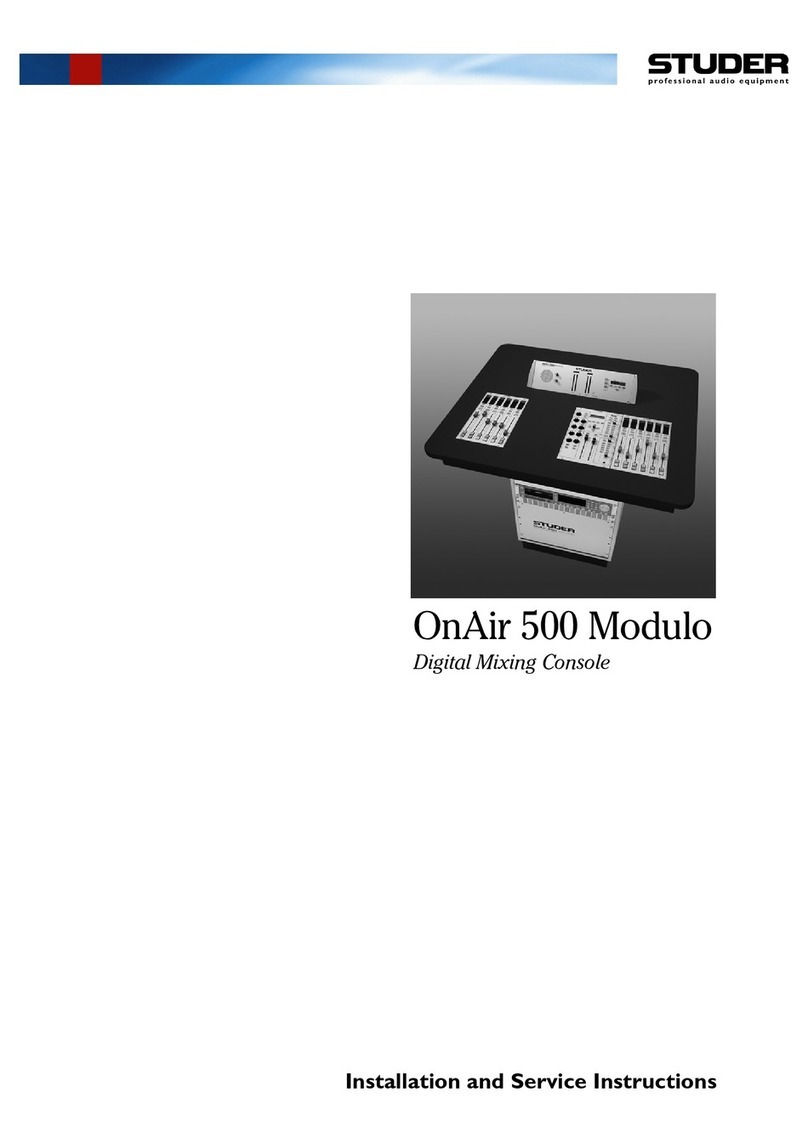
Studer
Studer OnAir 500 Modulo Quick guide
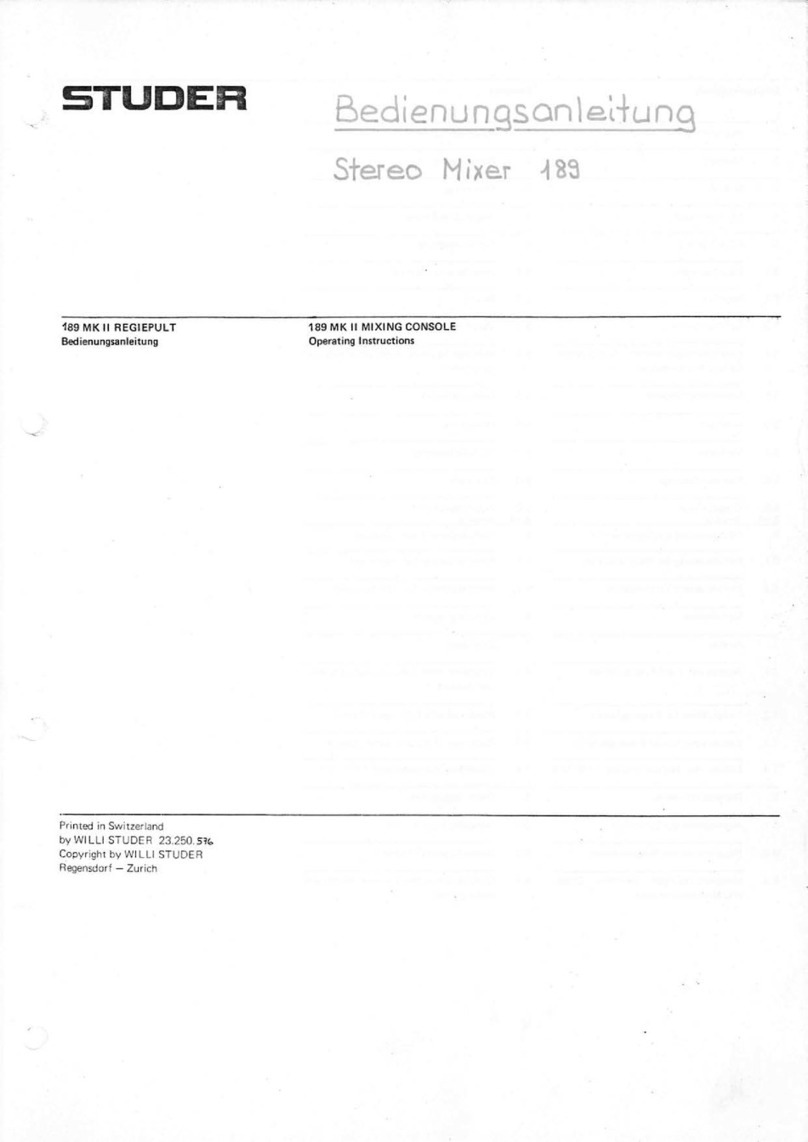
Studer
Studer 189 MK II Instruction sheet
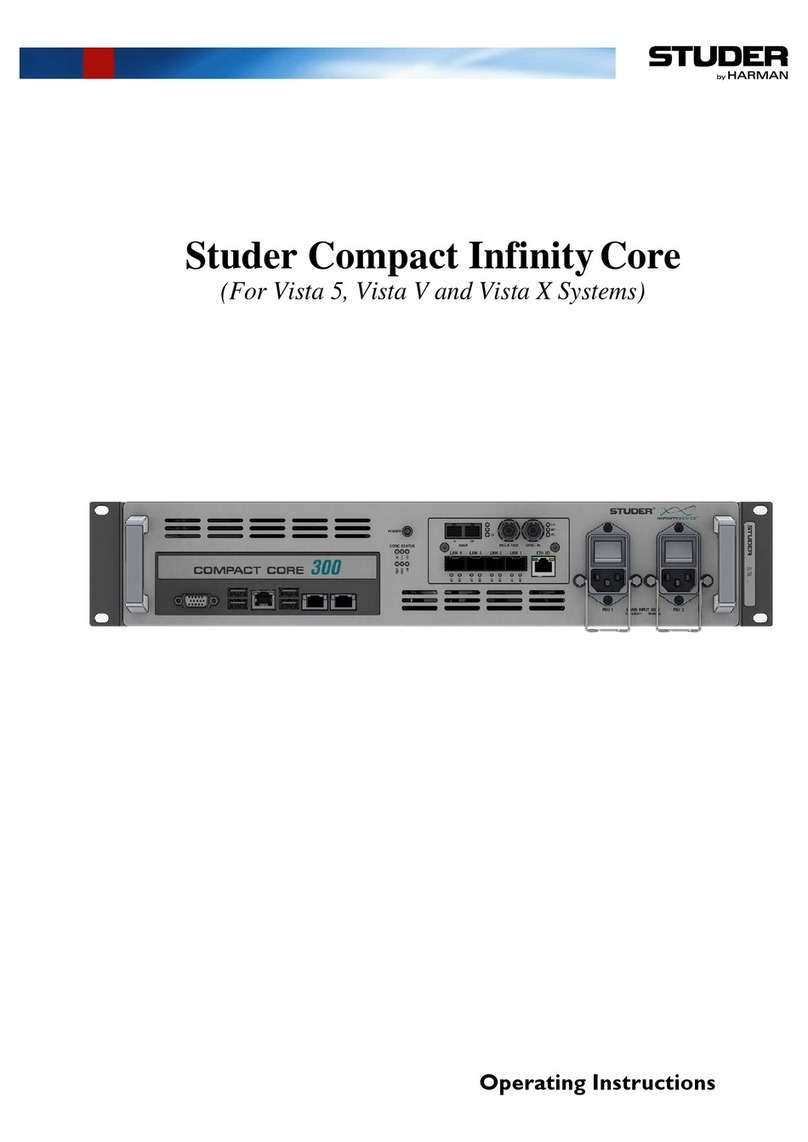
Studer
Studer Compact InfinityCore 300 User manual
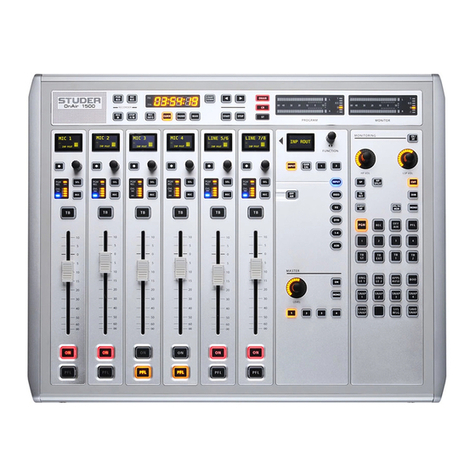
Studer
Studer OnAir 1500 User manual

Studer
Studer OnAir 1500 User manual
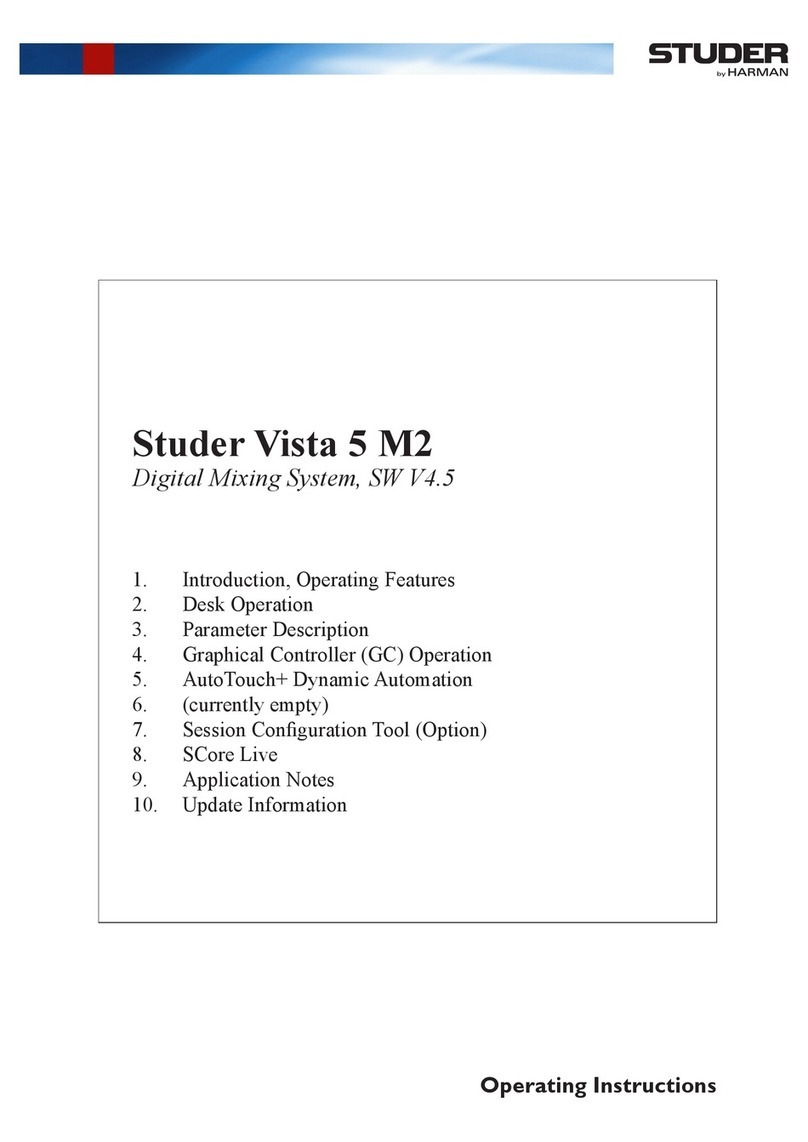
Studer
Studer Vista 5 M2 User manual
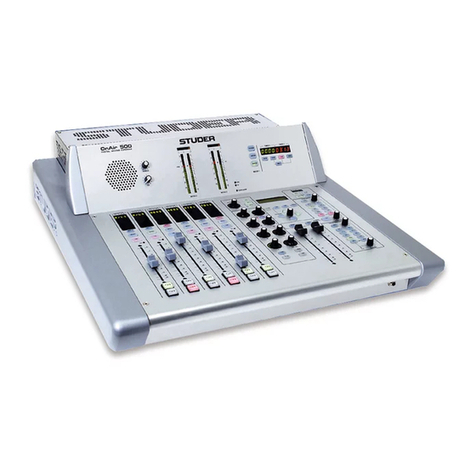
Studer
Studer OnAir 500 Modulo User manual
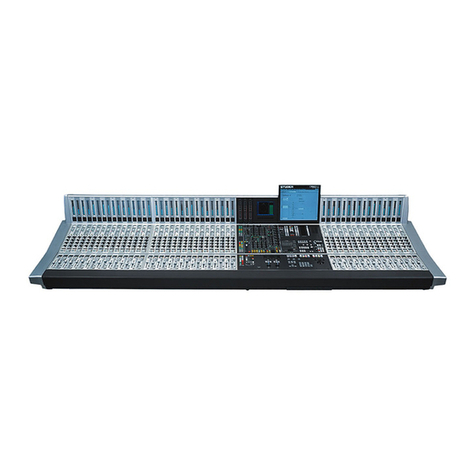
Studer
Studer D950 User manual
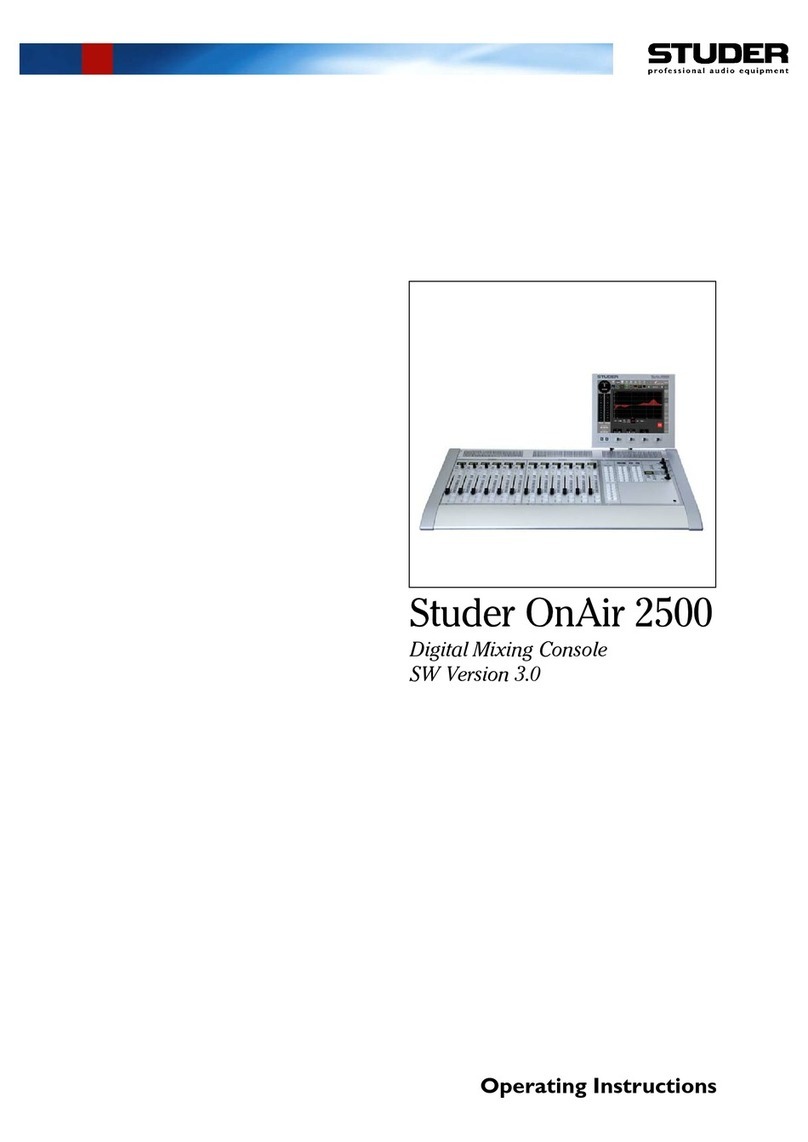
Studer
Studer OnAir 2500 User manual
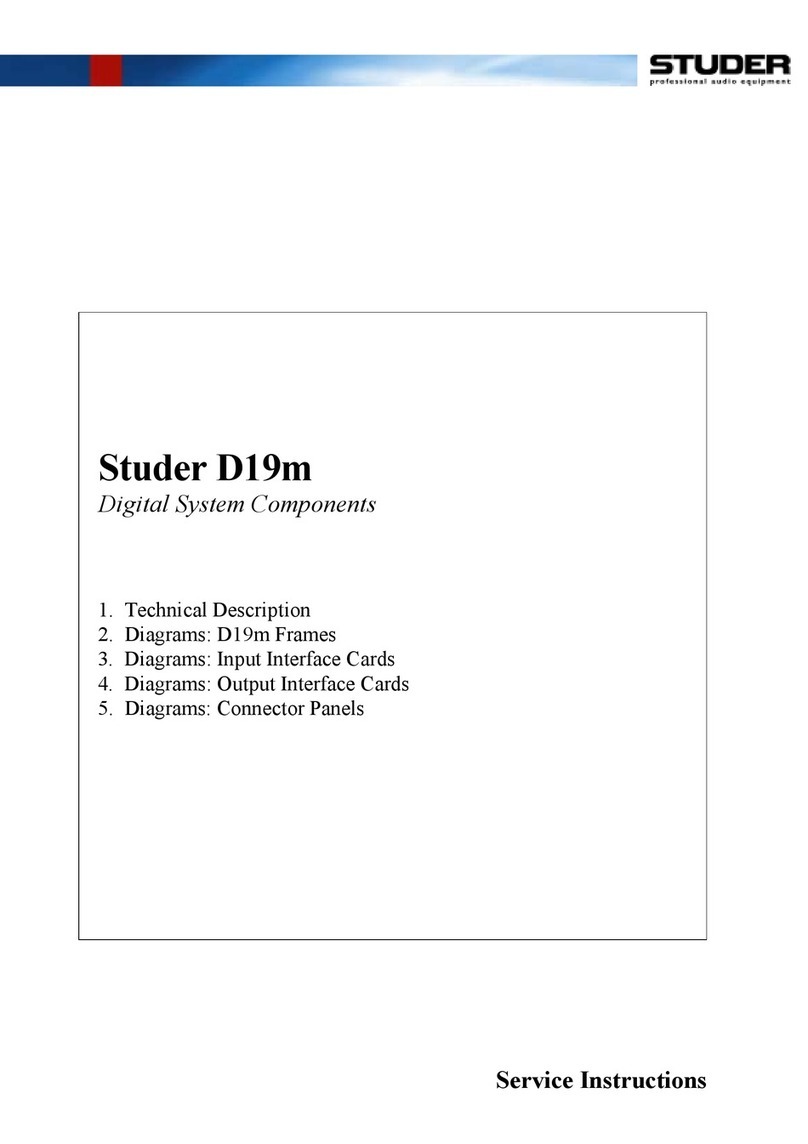
Studer
Studer D19m Operating instructions
